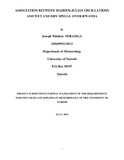| dc.description.abstract | The objective of this study was to examine the association between the Madden-Julian Oscillation (MJO) and wet and dry spells over Rwanda. Daily rainfall records and MJO indices was used in the study. The choice of daily MJO indices from 1979 to 2013 is based on the continuity of data as opposed to data from 1794, which has some missing data in 1978 and the choice of daily rainfall data from 1979 to 2013 was choosen to reflect the MJO indices. The methods used include temporal and spacial analysis, frequency analysis, correlation analysis and composite analysis.
The temporal and spatial analyses indicated that the rainfall peaks during the firts two weeks of March, which is the start month of the long rainfall season, starting from the western and southern part then to northern, central and estern part with high rainfall over the southern and western part of the country. This may be attributed to the westerly wind which inject moisture from Congo basin and the west fluctuation of the meridional arm of the ITCZ. The highlands of these regions also enhance convective development through orographic lifting.
The considerable number of wet spells during MAM season occurred between the third week of March and the second week of May while dry spells were located within the last two weeks of May. Composite of rainfall MJO indicated a well-established positive pattern between rainfall and wind component at lag zero and an opposite pattern between the rainfall and the Outgoing Long wave Radiation (OLR) component at the fifth lag.
The degree of association between MJO indices with daily rainfall was found to be moderately significant. The highest variance of daily rainfall explainable by Realtime Multivariate MJO principal component 2 (RMM2) indices is 25% while Realtime Multivariate MJO principal component 1 (RMM1) indices could explain a variance of16.8% | en_US |

